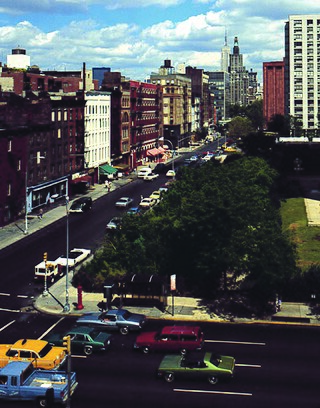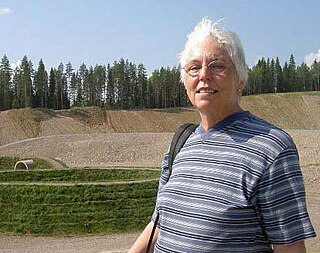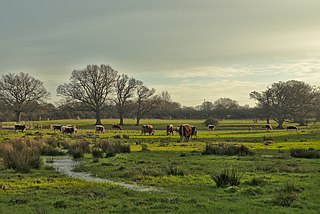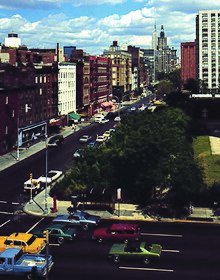
A woodland is, in the broad sense, land covered with woody plants, or in a narrow sense, synonymous with wood, a low-density forest forming open habitats with plenty of sunlight and limited shade. Some savannas may also be woodlands, such as savanna woodland, where trees and shrubs form a light canopy.

Strawberry Fields is a 2.5-acre landscaped section in New York City's Central Park, designed by the landscape architect Bruce Kelly, that is dedicated to the memory of former Beatles member John Lennon. It is named after the Beatles' song "Strawberry Fields Forever", written by Lennon. The song itself is named for the former Strawberry Field children's home in Liverpool, England, located near Lennon's childhood home.

Land art, variously known as Earth art, environmental art, and Earthworks, is an art movement that emerged in the 1960s and 1970s, largely associated with Great Britain and the United States but that also includes examples from many countries. As a trend, "land art" expanded boundaries of art by the materials used and the siting of the works. The materials used were often the materials of the Earth, including the soil, rocks, vegetation, and water found on-site, and the sites of the works were often distant from population centers. Though sometimes fairly inaccessible, photo documentation was commonly brought back to the urban art gallery.

An arboretum is a botanical collection composed exclusively of trees and shrubs of a variety of species. Originally mostly created as a section in a larger garden or park for specimens of mostly non-local species, many modern arboreta are in botanical gardens as living collections of woody plants and are intended at least in part for scientific study.

Mount Auburn Cemetery, located in Cambridge and Watertown, Massachusetts, is the first rural or garden cemetery in the United States. It is the burial site of many prominent Boston Brahmins, and is a National Historic Landmark.

Alan Sonfist is a New York City based American artist best known as a "pioneer" and a "trailblazer" of the Land or Earth Art movement.

Bailey Arboretum is a 42-acre (17 ha) arboretum located in Lattingtown, New York, a small village on the North Shore of Long Island. It opened to the public on Aug. 5, 1969 after being donated to Nassau County in 1968 by the heirs of Mr. and Mrs. Frank Bailey. Through an agreement with the Village of Lattingtown, admission to the arboretum was limited to 200 people at any one time.

The Morton Arboretum, in Lisle, Illinois, United States, is a public garden and outdoor museum with a library, herbarium, and program in tree research including the Center for Tree Science. Its grounds, covering 1,700 acres, include cataloged collections of trees and other living plants, gardens, and restored areas, among which is a restored tallgrass prairie. The living collections include more than 4,100 different plant species. There are more than 200,000 cataloged plants.

Environmental art is a range of artistic practices encompassing both historical approaches to nature in art and more recent ecological and politically motivated types of works. Environmental art has evolved away from formal concerns, for example monumental earthworks using earth as a sculptural material, towards a deeper relationship to systems, processes and phenomena in relationship to social concerns. Integrated social and ecological approaches developed as an ethical, restorative stance emerged in the 1990s. Over the past ten years environmental art has become a focal point of exhibitions around the world as the social and cultural aspects of climate change come to the forefront.

Nancy Holt was an American artist most known for her public sculpture, installation art, concrete poetry, and land art. Throughout her career, Holt also produced works in other media, including film and photography. Since 2018, her legacy has been cared for by Holt/Smithson Foundation.
Environmental sculpture is sculpture that creates or alters the environment for the viewer, as opposed to presenting itself figurally or monumentally before the viewer. A frequent trait of larger environmental sculptures is that one can actually enter or pass through the sculpture and be partially or completely surrounded by it. Also, in the same spirit, it may be designed to generate shadows or reflections, or to color the light in the surrounding area.

A natural landscape is the original landscape that exists before it is acted upon by human culture. The natural landscape and the cultural landscape are separate parts of the landscape. However, in the 21st century, landscapes that are totally untouched by human activity no longer exist, so that reference is sometimes now made to degrees of naturalness within a landscape.
Alan Gussow was an American artist, teacher, author and conservationist devoted to and inspired by the natural environment.

Despite being a relatively small country, Albania is exceedingly rich in biodiversity. Its ecosystems and habitats support over 5,550 species of vascular and non-vascular plants and more than 15,600 species of coniferous and non-coniferous evergreens, most of which are threatened at global and European levels. The country has made recent efforts to expand its network of protected areas which now include: 11 national parks, 1 marine park, 718 nature monuments, 23 managed nature reserves, 11 protected landscapes, 4 World Heritage Sites, 4 Ramsar sites and other protected areas of various categories, that when combined, account for 21.36% of the territory. Furthermore, a biosphere reserve, 45 important plant areas and 16 important bird areas are found in the country.
Ecological art is an art genre and artistic practice that seeks to preserve, remediate and/or vitalize the life forms, resources and ecology of Earth. Ecological art practitioners do this by applying the principles of ecosystems to living species and their habitats throughout the lithosphere, atmosphere, biosphere, and hydrosphere, including wilderness, rural, suburban and urban locations. Ecological art is a distinct genre from Environmental art in that it involves functional ecological systems-restoration, as well as socially engaged, activist, community-based interventions. Ecological art also addresses politics, culture, economics, ethics and aesthetics as they impact the conditions of ecosystems. Ecological art practitioners include artists, scientists, philosophers and activists who often collaborate on restoration, remediation and public awareness projects.

Park of the Laments is a public artwork by Chilean artist Alfredo Jaar, located in the Virginia B. Fairbanks Art & Nature Park: 100 Acres, in Indianapolis, Indiana, United States. The artwork consists of an enclosed park space in the form of a square placed within a square, the inner parameter being made from limestone-filled gabion baskets, and the outer from indigenous trees and shrubs. The park space is only accessible by a concrete enclosed tunnel. The installation has a landscape design that consists of over 3,000 individual plant species from 53 different genera.
Actual Art is a genre of art that was first named by critic Alfred Frankenstein of the San Francisco Chronicle in a review of Helene Aylon’s work. The name was chosen because the art was "real", but the term realism was already in use. Frankenstein described Aylon's work as a genre of art that involves “the self-conscious enlistment of the forces of nature, by artists, toward the completion of their art”. Collaboration with nature necessarily brings the dimension of time into as an integral component of the artworks, with some requiring many thousands of years for their completion. The artists consider the future of the work to be as important as its present, relinquishing control over the work to nature.

Western Sydney Regional Park is a large urban park and a nature reserve situated in Western Sydney, Australia within the suburbs of Horsley Park and Abbotsbury. A precinct of Western Sydney Parklands, a park system, and situated within the heart of the Cumberland Plain Woodland, the regional park features several picnic areas, recreational facilities, equestrian trails, and walking paths within the Australian bush.

The Cumberland Plain Woodland, also known as Cumberland Plain Bushland and Western Sydney woodland, is a grassy woodland community found predominantly in Western Sydney, New South Wales, Australia, that comprises an open tree canopy, a groundcover with grasses and herbs, usually with layers of shrubs and/or small trees.

The wood-pasture hypothesis is a scientific hypothesis positing that open and semi-open pastures and wood-pastures formed the predominant type of landscape in post-glacial temperate Europe, rather than the common belief of primeval forests. The hypothesis proposes that such a landscape would be formed and maintained by large wild herbivores. Although others, including landscape ecologist Oliver Rackham, had previously expressed similar ideas, it was the Dutch researcher Frans Vera, who, in his 2000 book Grazing Ecology and Forest History, first developed a comprehensive framework for such ideas and formulated them into a theorem. Vera's proposals, although highly controversial, came at a time when the role grazers played in woodlands was increasingly being reconsidered, and are credited for ushering in a period of increased reassessment and interdisciplinary research in European conservation theory and practice. Although Vera largely focused his research on the European situation, his findings could also be applied to other temperate ecological regions worldwide, especially the broadleaved ones.
















